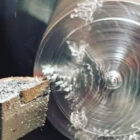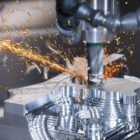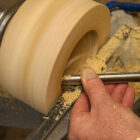Boring is a critical process that machinists must execute in order to enlarge holes to a required diameter and achieve tight tolerances. However, working with small diameter holes presents a substantial challenge. Careful tool selection, setup, and procedures are necessary for small diameter boring to produce the desired results without sacrificing surface finish or precision. This manual will concentrate on resolving the particular difficulties associated with boring tiny holes and offer practical advice for machinists seeking to increase accuracy in these tight spaces.
Challenges in boring holes with small diameters
Machinists have a number of difficulties to overcome while boring holes with small diameters. These challenges stem from the intrinsic constraints of the tools being used and the characteristics of the materials being machined.
- Limited tool rigidity: In order to fit into small spaces, boring bars used in small diameter holes are usually slender. Reduced rigidity causes the bar to become narrower, which increases deflection under cutting forces. Inaccuracies in dimensions and poor surface finish may arise from this deviation.
- Vibration and chatter: Smaller boring bars are more likely to experience vibration and chatter, which can shorten the tool’s life and degrade the hole’s quality. Vibrating is more likely when machining at high speeds or with insufficient tool support.
- Limited chip evacuation: Chip evacuation is frequently restricted when small diameter holes are bored. In addition to degrading the surface quality, chips that are not carefully removed might jam or harm the cutting tool.
- Heat generation: Because smaller tools have less material contact with the cutting edge, heat is concentrated in a smaller area. This may shorten the life of the tool and cause heat expansion, which could compromise dimensional accuracy.
- Tight tolerances and surface finish: When working with small components in many machining applications, it’s imperative to maintain tight tolerances. It might be challenging to maintain the necessary tolerances and the proper surface polish in such small areas.
Choosing the right tool to bore small diameter holes
When working with small diameter holes, choosing the appropriate tool is essential. The material to be machined, the hole’s depth, and the desired finish are all taken into account.
- Boring bar material: Solid carbide and other similar materials have a high degree of stiffness and resistance to deformation, making them ideal for small diameter boring bars. Tool stability may be effectively maintained, even in small areas, with the help of carbide boring bars. Although they are less stiff than carbide and might not work as well in applications requiring fine tolerances, high-speed steel (HSS) boring bars are still an option.
- Length-to-diameter ratio: The ratio of length-to-diameter is one of the most important factors to consider when choosing a boring bar. Deflection and chatter are more common when the length grows in relation to the diameter because of a loss in stiffness. Maintaining a low length-to-diameter ratio is essential for tiny diameter holes in order to reduce deflection. If the bore is deep, you might want to use long-reach boring specialized gear.
- Tool geometry: Reducing cutting forces and enhancing chip evacuation are greatly influenced by the cutting edge’s geometry. To lessen cutting forces and increase chip flow, select a boring bar with a positive rake angle. For small holes, sharp-edged tools work best because they provide smooth, vibration-free cuts.
- Solid vs. indexable boring bars: Indexable boring bars are better suited for applications requiring multiple tools because they make it easy to replace the cutting insert. Nonetheless, solid carbide bars may offer superior stiffness and stability at extremely small diameters when compared to indexable alternatives.
Setup considerations for accuracy in tight spaces
The quality of the machining process is directly impacted by the boring bar setup. The dangers of deflection, vibration, and heat accumulation can be reduced with proper setup. Here are a few crucial pointers for setting up tiny diameter hole boring.
- Correct alignment: The secret to reducing tool deflection is alignment. It is important to position the boring bar parallel to the hole’s centreline in order to prevent uneven cuts and chatter. Before beginning the operation, use a dial indicator to verify that the tool is aligned correctly and make any necessary changes.
- Proper tool support: It is crucial to make sure the boring bar is firmly secured and supported in order to minimize vibration. Stability can be significantly increased by using anti-vibration boring bar holders, particularly in deeper bores. Reduce the tool’s overhang as much as possible if the machine setup permits. By limiting the length of the bar’s extension from the holder, chatter can be minimized and stiffness increased.
- Suitable feeds and speeds: It’s critical to maximize your feed rate and cutting speed for small diameter boring. While operating at too low a speed could lead to a poor surface finish, operating at too high a speed can produce excessive heat and cause tool wear. For advice unique to your particular tool and material combination, always refer to the manufacturer’s instructions. Generally speaking, deflection and vibration can be reduced by starting at slower speeds and increasing feed rates.
- Cutting fluid: Cutting fluid is essential for cooling and lubrication purposes in small diameter boring. By lowering heat accumulation at the cutting edge, the fluid prolongs tool life and keeps the workpiece from thermally deforming. Make sure, particularly in deeper holes, that the cutting fluid reaches the bottom of the bore. Chip evacuation and heat control can be achieved with flood cooling or through-tool coolant delivery.
As we can see, achieving precision in small diameter boring doesn’t come easy, but with the right approach, it’s possible to consistently achieve tight tolerances and produce quality results in even the most confined spaces. You may increase the efficiency of your machining operations overall and optimize your small diameter boring processes by implementing the advice spoken of in this blog. FineTech Toolings is one of the most reputed precision boring bars manufacturers in Bangalore, well known for manufacturing precision boring bars that are suited for a range of machining tasks. The top-notch tools available here are made to last, even for the most difficult tiny diameter boring jobs. This helps machinists accomplish better machining efficiency and precise tolerances.






